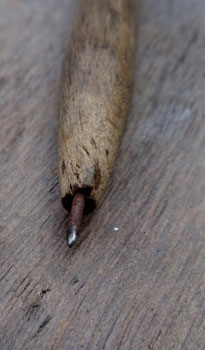
|
 |

|

|

|

|

|

|

|
 |

Partagez
avec nous vos astuces, vos suggestions,
et profitez des trouvailles des autres
Recipe for white
(soap) ground. 1 volume of linseed oil 2 volumes of titanium
white dry pigment 4 volumes of Ivory Snow (pure soap granules/flakes)
2 volumes of water The soap granules and the white pigment are first
mixed in the dry state. The linseed oil is gradually added little
by little into the mixture. Nest add the water until a soft paste
is formed. The paste should be stored in a covered jar so the water
will not evaporate. A light tendency of the oil to separate from the
mixture is remedied by stirring before each use. During use this basic
mixture is varied in consistency by thinning with water. procedure
1. Degrease the copper plate. 2.Aquatint pr spray the plate with paint.
3. Put some white ground onto a lid or small plate. Have some water
and a variety of brushes handy. Mix white ground so it is a creamy
consistency and paint it freely on your plate. Thinner white ground
will produce darker grays, thicker amounts with produce lighter grays
4. You can build layers of white ground, drying each layer before
proceeding to the next. You may remove the ground with a rag or thin
it with a spray water bottle at any point. 5. If you want a black
line, take the edge of a piece of cardboard or the end of a paintbrush
a draw through the ground. 6. If possible let the plate sit overnight.
Otherwise, some of the ground may lift off when you bite it. 7. Bite
the plate to black (for at least 40 minutes in ferric chloride). 8.
Clean brushes. Clean ground off plate after biting and before Cloud
Stop out I think I might have finally come up with a really good white
ground recipe. This one evolved from trying a mixture of equal parts
petroleum jelly and dry titanium white pigment, for a permeable ground
that would not dry but stay greasy and easily reworkable after being
applied. Mixing equal parts petroleum jelly and titanium white pigment
makes a wonderful soft edged, permeable white ground except for one
thing. The Vaseline (petroleum jelly) has a thin oil in it that seeps
out and "halos" like crazy if it is allowed to sit for any amount
of time. This isn't a problem if you're doing something with feathered
edges, and etching in one step soon after applying the ground to the
plate. However if you're doing step-biting and spreading it out over
several days, the "halo" or "bloom" turns into a resist (hard to see)
which blocks further etching so after doing your step-biting you discover
that you only etched the lighter tones and there aren't any darks.
Bad. So I added the soap to kill the "grease slick", and it seems
to work much like before the soap, only now you can thin it with water.
It dries to a fairly soft greasy consistency, but you do need to allow
it to air-dry before etching. This means leaving it exposed to the
air for 15 minutes or a half hour, or less time with a fan or compressed
air. Avoid warming it, since this tends to make the oil seep out of
it. Like all greasy/soapy grounds, you can thin it with water and
it will wash off under running water until it's been in the acid/ferric
chloride, which "fixes" it so that a plate coming out of the acid
can be rinsed under water without washing the ground off. You do need
to be careful when rinsing and/or drying with compressed air, especially
if it has been in the acid less than a minute or two since it can
be very easy to dislodge. |
 |
 |
 |
 |
 |
 |
 |
 |
 |
 |
|